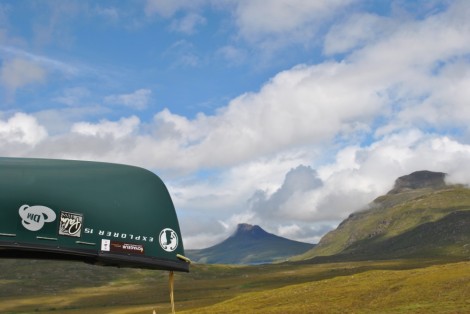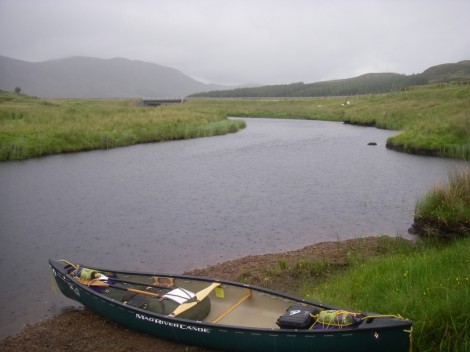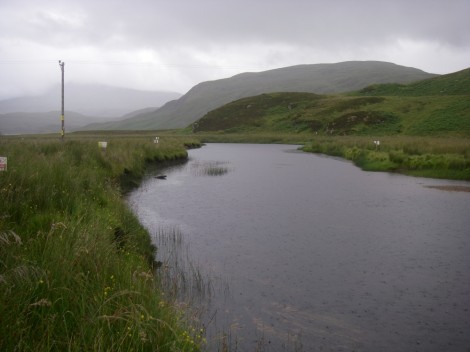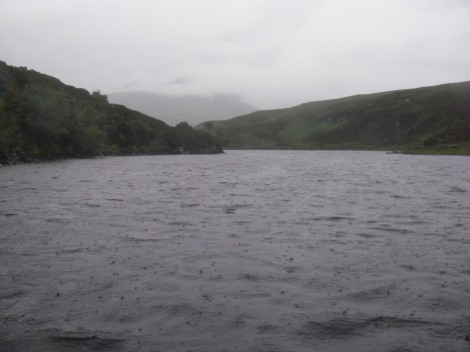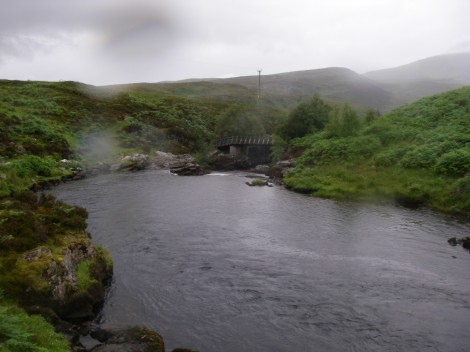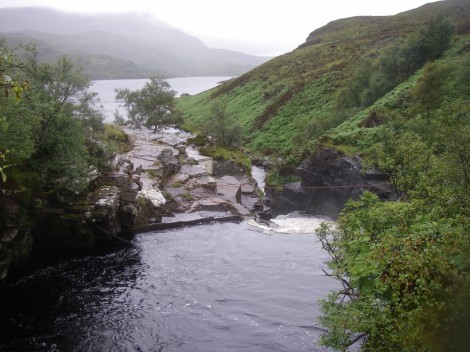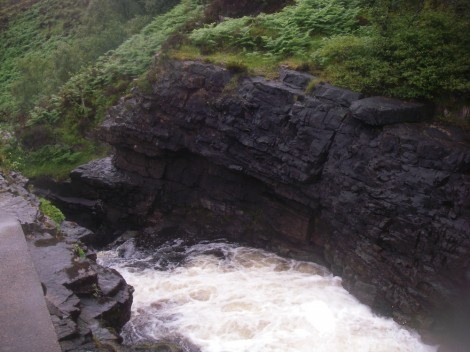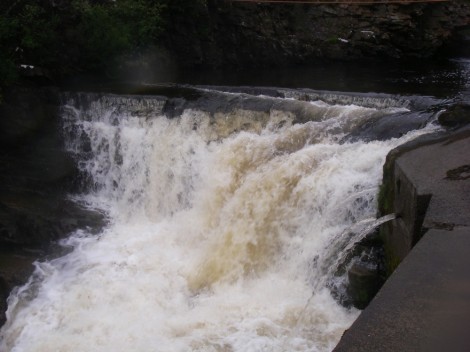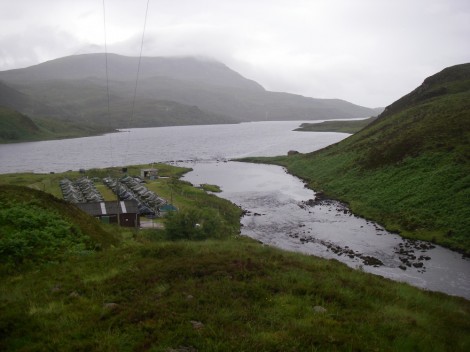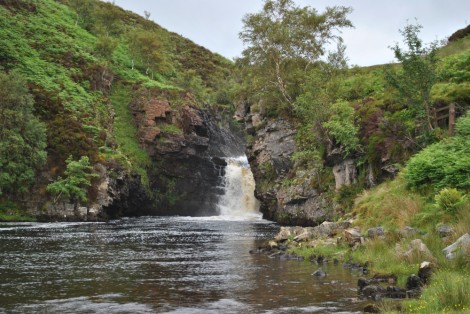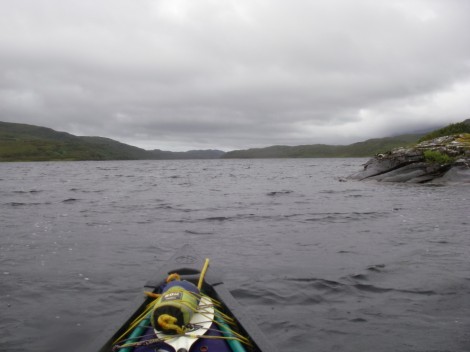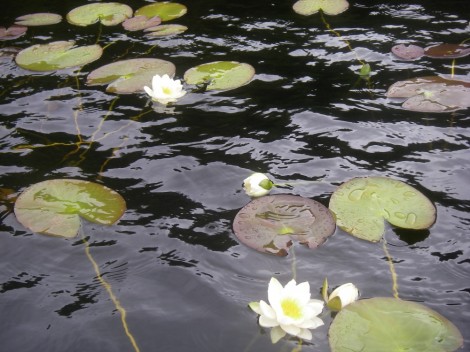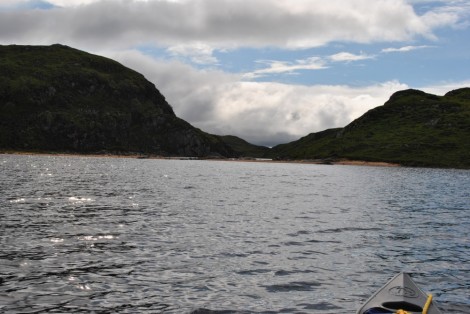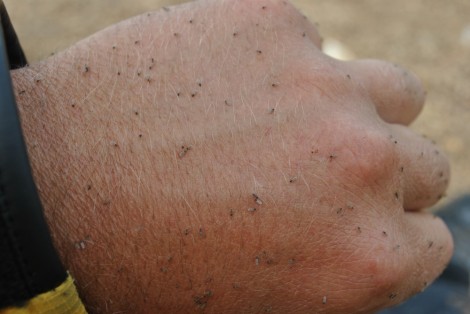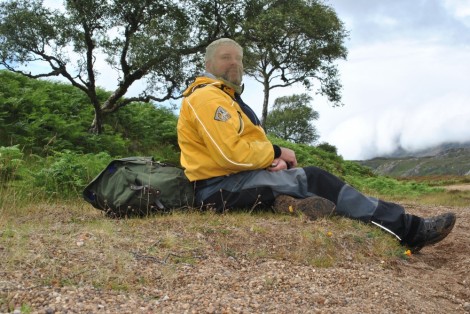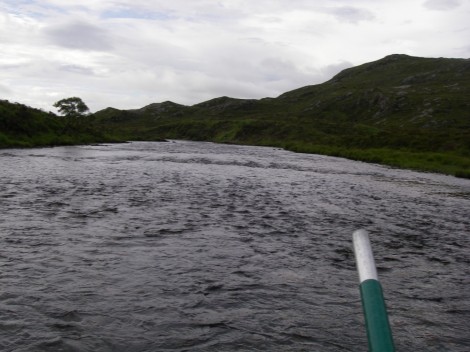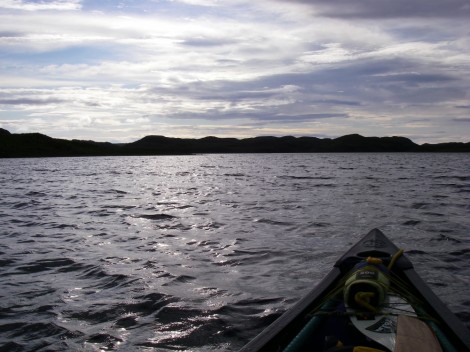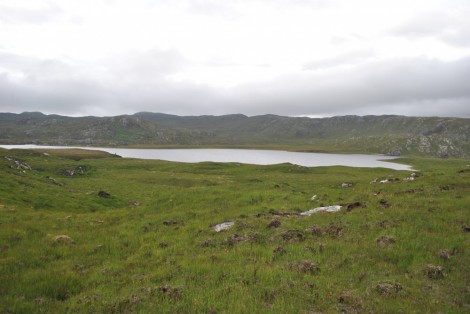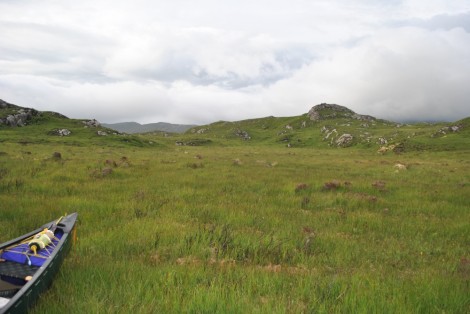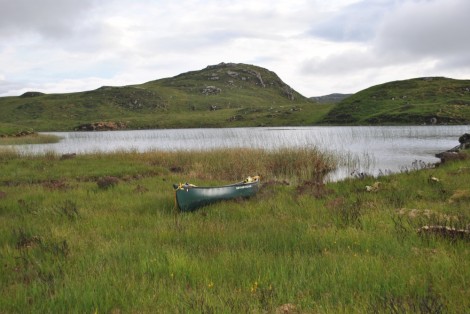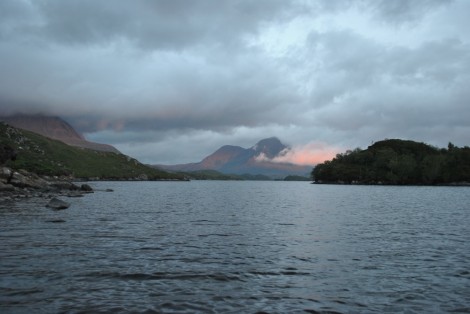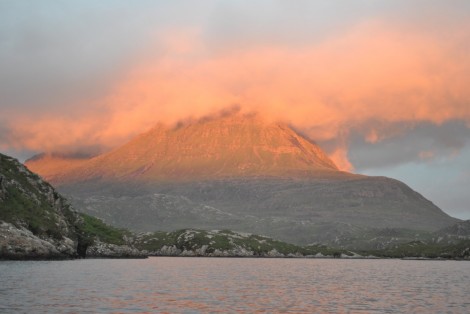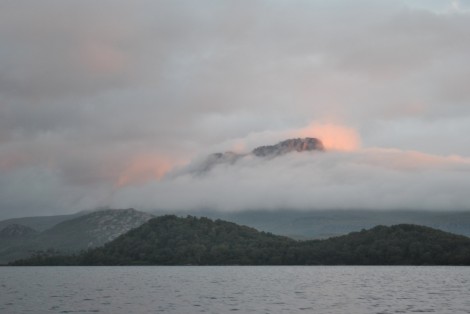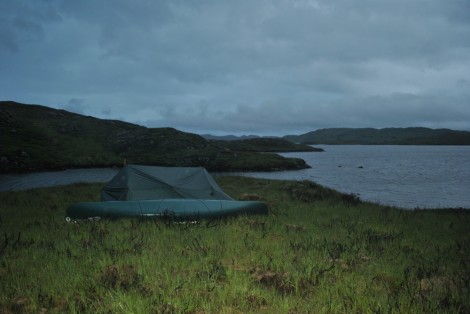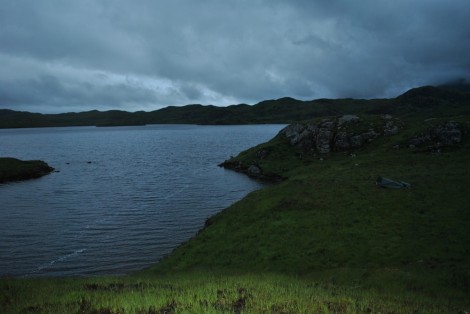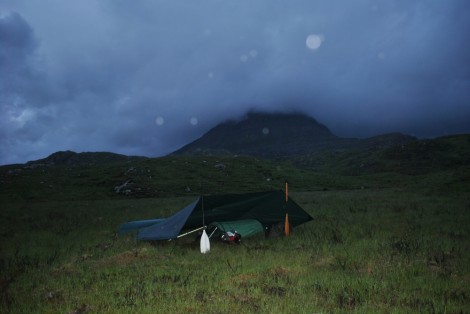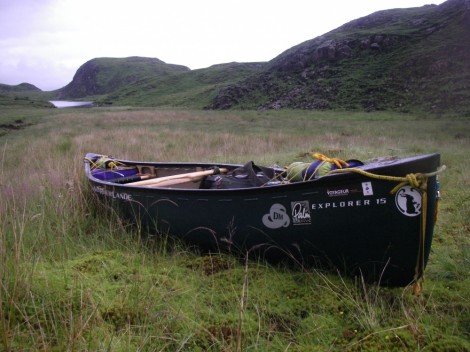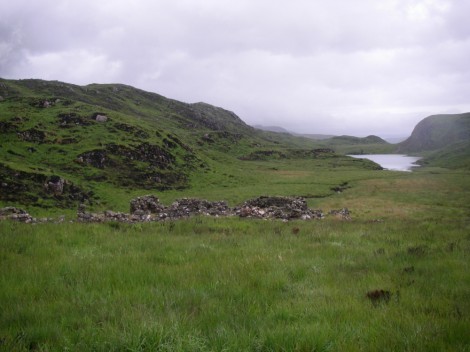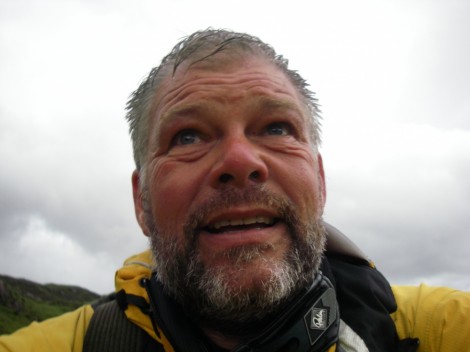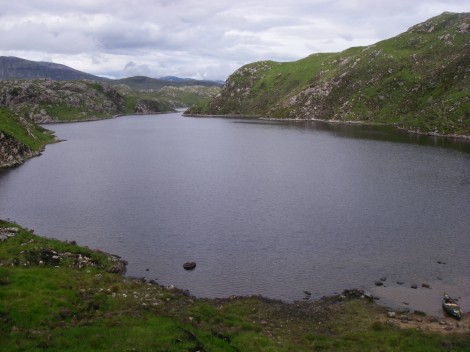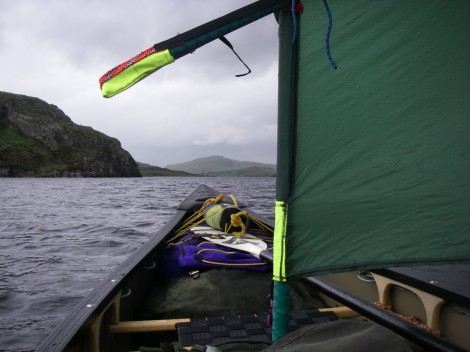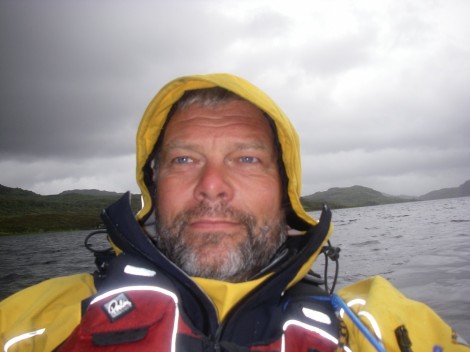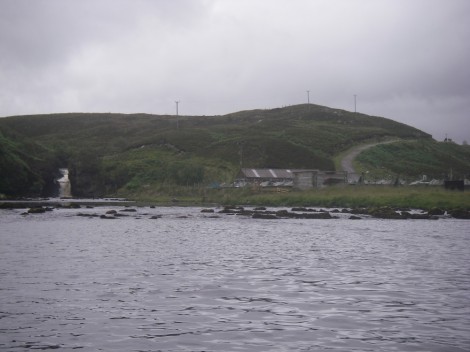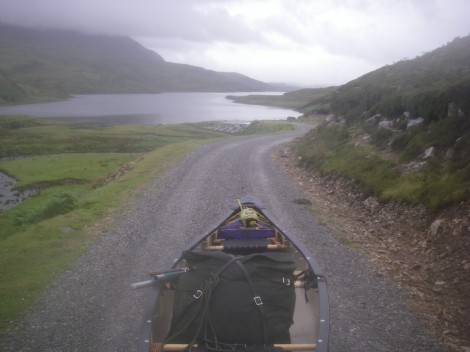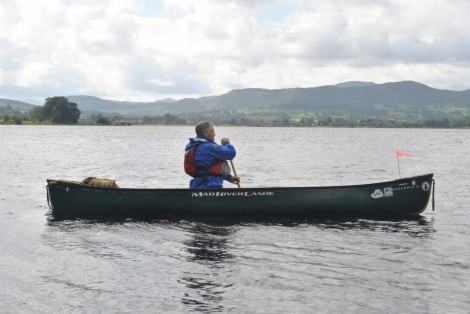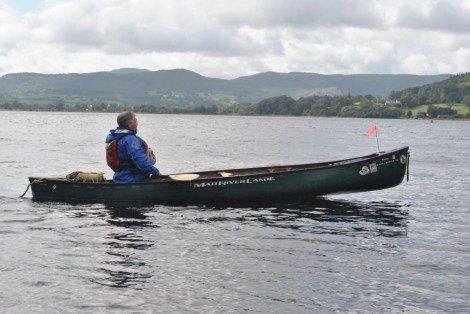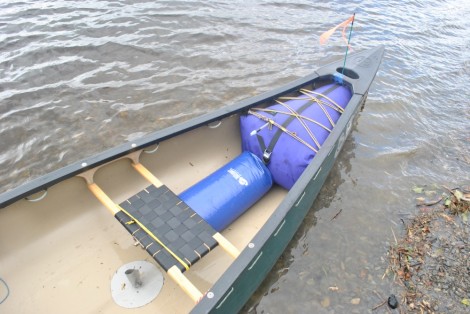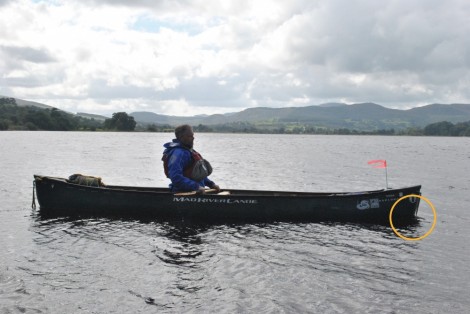Sunset over Sionascaig
Finally as the sun was setting and after more than nine and a half hours of paddling, poling, portaging, grunting and groaning, and enduring everything from bright sunshine to wind and rain I was treated to my first glimpse of my planned destination. That location was Sionascaig, a beautifully wild and remote loch in the far north of the Scottish highlands surrounded by some spectacular mountains.
I had been wanting to explore this area for a while after having spent some time researching it and pouring over maps thinking how interesting the area looked. When planning I’m always looking at how I can link up watersheds or how I can extend previous trips. Being that I’m not a particularly sociable beast and that I enjoy my own company, plus I really like the challenges presented by solo expedition paddling, I felt that this trip would lend its self well to this style of expedition. Careful consideration should be given to any solo ventures remembering the associated hazards, especially should something go wrong. I always leave details of my intended route with a friend together with details of what to do if they don’t hear from me at certain times. As a safety system I carry a GPS tracking device which allows people to track me but also has a built in message service allowing me to check in and let the world know I’m ok, plus alert the emergency services should I really need them. As best I can I make sure Im self sufficient and that Im not going to be putting anyone else at risk.
Sionascaig is a part of a series of lochs in the Inverpolly National Nature Reserve which lies to the North of Ullapool in the Scottish highlands. It is part of a system which includes Cam Loch, Loch Veyatie, Fionn Loch and Loch Sionascaig. The skyline to the north is dominated by the peaks of Suilven and Canisp whilst to the south are Cul Mor, Cul Beag and the classic ridge of Stac Polly.
You can view the area and my route in Google Maps HERE
As I left Dingwall the sun was shining with blue skies, however as I headed north the cloud thickened and the inevitable wind and rain started! I passed the track leading down to the fish farm on Loch Veyatie and found a small pull in off the road with good access to a tributary flowing into Cam Loch, loaded my boat and launched. I had chosen my Mad River Explorer 15 as my boat. I love this as my expeditioning boat. With its shallow “V” hull it tracks well and is equally at home on moving and open water.
I spent a couple of hours exploring Cam Loch before heading to the South West corner in search of a waterfall leading to Loch Veyatie and the first of many portages on this trip.I was quite taken a back when I turned a corner in the narrowing loch, as the the water a short distance in front of me disappeared out of view! For some unknown reason I had been expecting the waterfall to be flowing towards me rather than away and into Veyatie.
The waterfall itself is quite spectacular and the short portage around it rather interesting as it drops 12m in a very short distance. Portage complete and with my boat loaded Loch Veyatie was now stretching away northwards for 7km to my front.
After some 5 km of paddling a large bay opens up on the western shore. This marks the point at which there is a portage between the Lochs Veyatie and Sionascaig and as this was the portage I intended to use on my return I thought I would check it out, and also take the opportunity for a break and some lunch.

This was the view of my forthcoming portage between the Lochs as seen from the Loch Veyatie side with Sionascaig just visible in the distance. Challenging me thinks !!
By this time the rain and wind had subsided and was replaced with sunshine which was an invite for the legendary Scottish midges to make an appearance. They don’t normally bug me but on this occasion as there was no other option available, they feasted on me! I carry a head net in my PFD for just such an occasion which I normally put on just before landing and for short periods. I also carry a full midge jacket which I then put on for longer periods once settled.
A few km’s later the Loch becomes a river and I was now being overshadowed by the classic peaks of Suilven. This gave me the opportunity to engage in a spot of downstream poling, which was a great way to stretch my legs. Not that this would be a problem soon with another portage looming. Some distance later after picking my way through the twists and turns, the flow slows and you find yourself in the calmer waters of Fionn Loch.
I was now looking for a bay on the west side where the water leaves the loch and heads downhill heading for the Falls of Kirkaig. At this point I needed to leave the Loch and try and find a portage route across to Sionascaig.
This wasn’t to be an easy portage, with over 2 km of rough ground to cover and no chance of a trolley being used. I like to keep the legs short whilst portaging, sticking to 100m at a time, and always carrying my kit first and then returning for my boat. This then allows me to vary my route and select the best option for when Im carrying my boat. Several times I managed to loose either my boat or kit and on one occasion both whilst walking back and forth. Eventually I found myself looking down the final 500m of the remaining portage that would take me into Sionascaig, accompanied by some spectacular sunsets over the surrounding mountains.
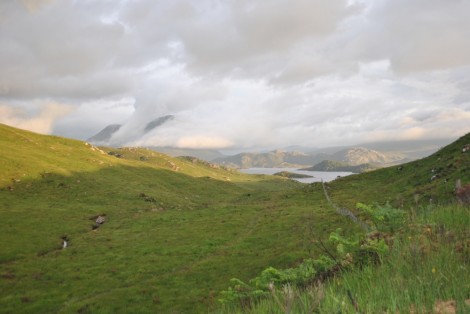
After nine and a half hours of paddling, poling and portaging Sionascaig was now in clear view and it was all downhill
It felt good to have water under my boat again as I paddled a couple of km around to Boat Bay. After searching around a bit for a good bivy site, I eventually set my tarp up for the night in a sheltered spot opposite Boat Bay, sorted some food and went to bed tired but happy. Luckily I had taken a hooped bivy bag with me, which saved me from a night of misery courtesy of the midges.
Next day after a late start I spent the day exploring Sionascaig further before finding a new bivy spot very close to the start of the portage trail back over to Loch Veyatie. As I settled down for the night the weather was turning with the wind building and light but steady rain.
I could hear the weather worsening as it whipped and lashed at my tarp making sleeping a challenge. This continued throughout the night until at around 0430 a huge squall flattened my tarp! Luckily because of the way my tarp was set with my boat along the back edge it didn’t take off and disappear. I crawled out into the pouring rain and wind and surveyed the situation. As it was nearly light I decided to quickly pack and retreat to Loch Veyatie via the previously mentioned portage route.
Kit packed I set off with my familiar routine of kit first and then boat, again with the legs kept to around 100 m. It was hard going as there was no real path just a wet, tussock strewn 2 km of slog, all slightly up hill and then there was few hundred metres descent down to the water in a sheltered bay. I was quite tired and hungry at this point so stopped for breakfast before continuing.

Careful route selection was essential. This was the ground for most if not all the 2km, and its all slightly uphill !
As luck would have it the rain had eased and the wind was blowing down the Loch in the direction I was heading. I quickly rigged my solo sail, sat back and enjoyed the swift journey down the Loch to the fish farm I had passed previously.
Unfortunately there was no vehicle access down from the road to the farm, so I set off on foot back to my car, moved it to the gate at the top of the track and returned to my boat with a portage trolley. With my boat strapped on I set off on the last part of my journey back to my car before heading back to Dinngwall.
I thoroughly enjoyed the trip, despite the bad weather that woke me and cut my trip short. There is lots of scope to extend this trip and include a few more lochs. I could easily have spent more time exploring Sionascaig, in fact I would very much like to head back there soon and maybe even take in one of the surrounding peaks or ridges. A beautiful place with stunning views and well worth a trip. Go and see for your self.
Meanwhile here is a little collection of memories from my trip. Hope you enjoy it
Music by Dan-O at DanoSongs.com
Happy paddling and see you on the water…..
Jules
Bespoke Canoe Coaching, Guiding, Safety & Rescue training and BCU awards









